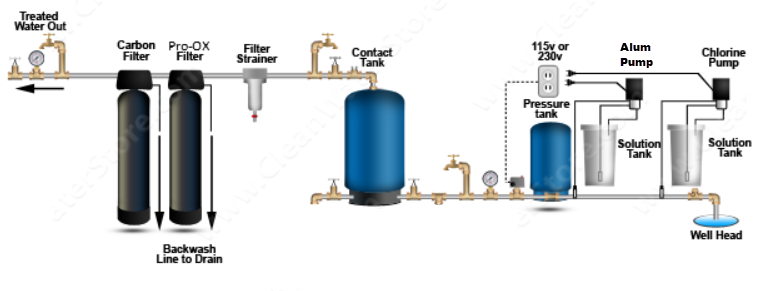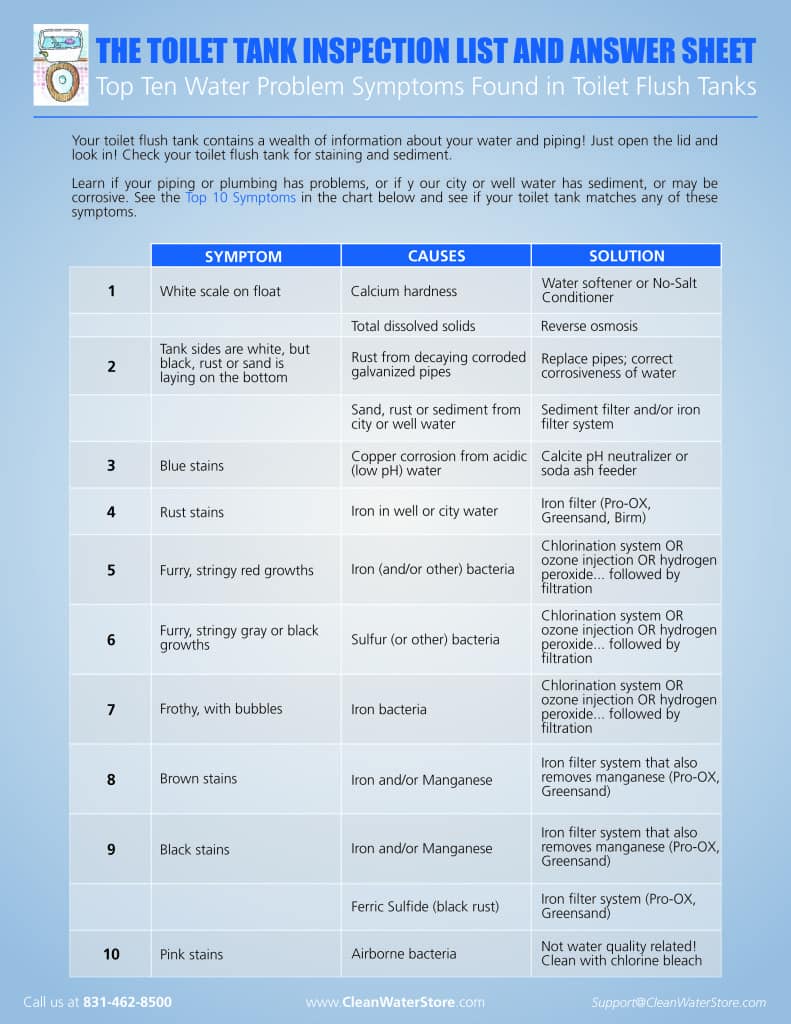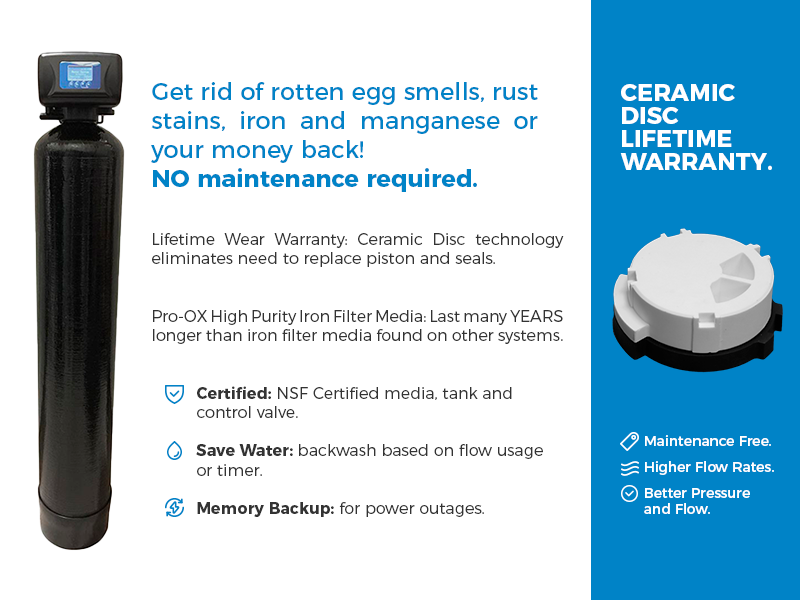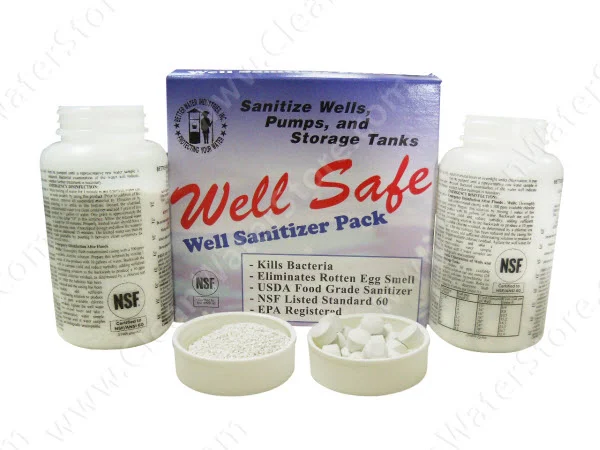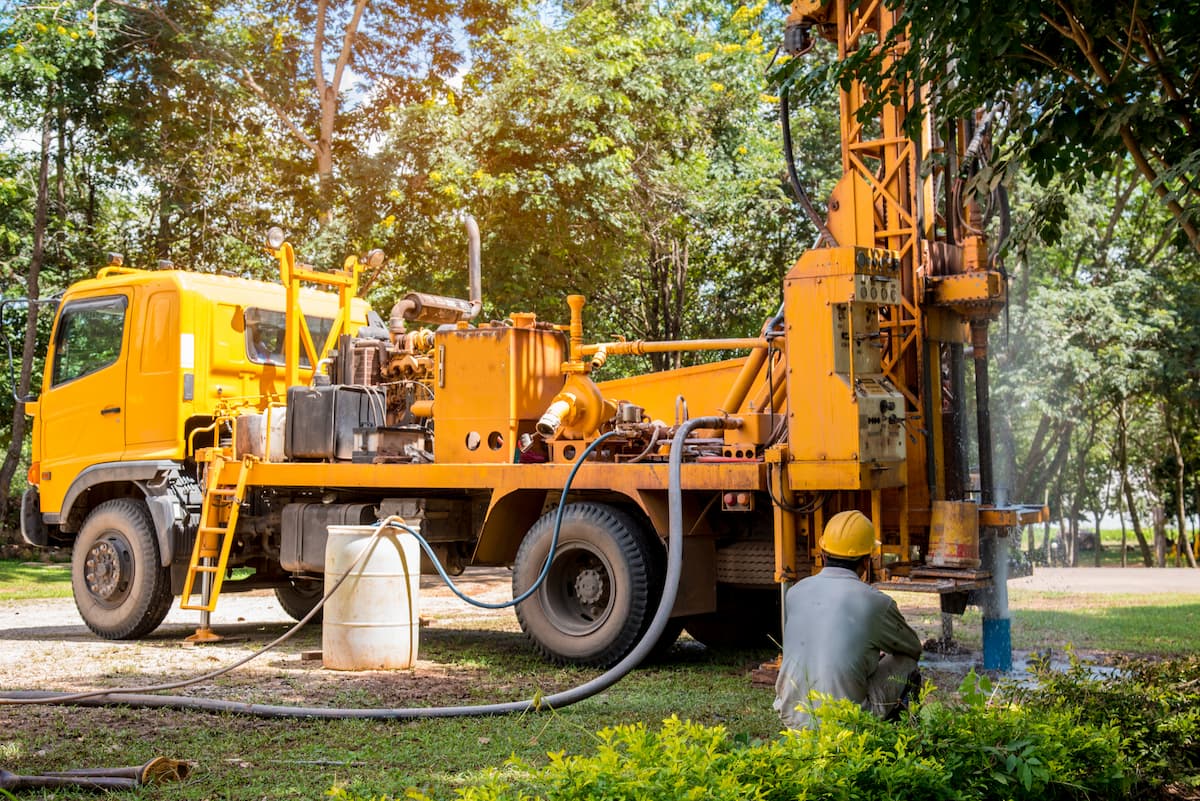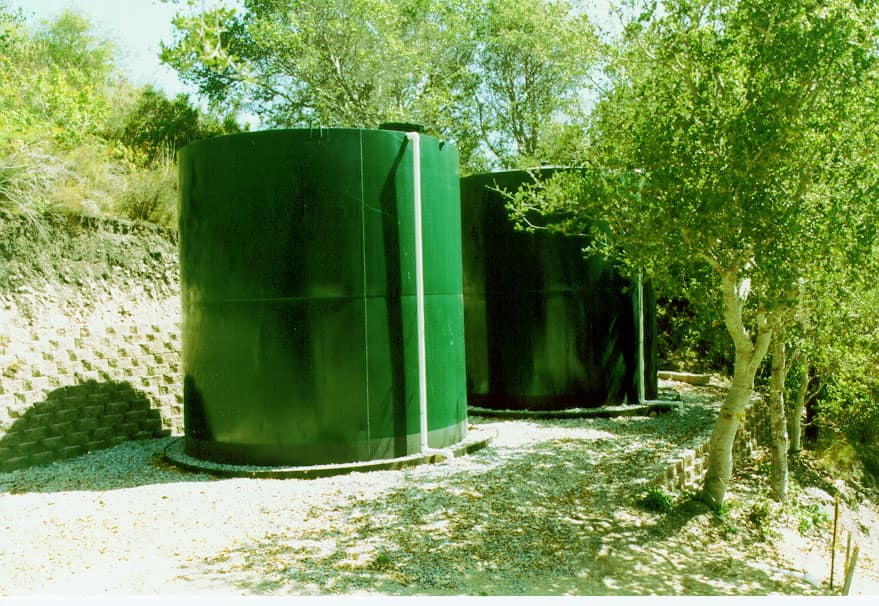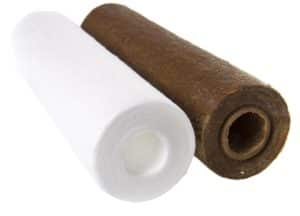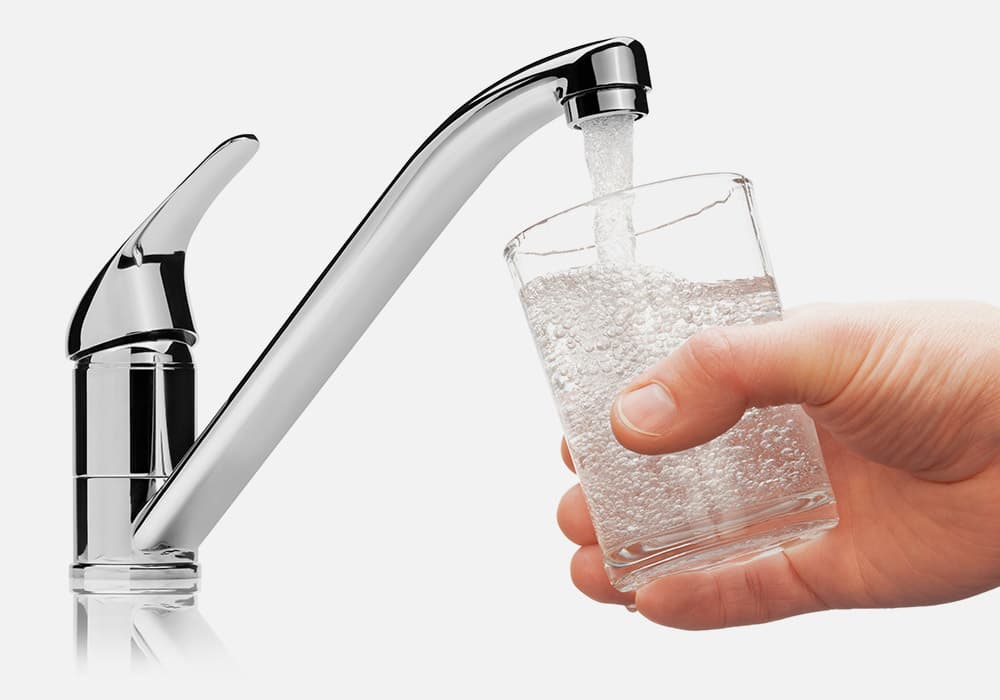How to Remove Iron, Manganese, and Odor From Well Water
Iron and Manganese
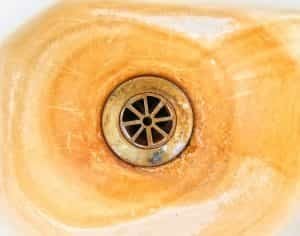
Iron is one of the earth's most plentiful resources, making up at least five percent of the earth's crust.
In well water, you find iron in a dissolved state so water may appear clear when first drawn from the tap.
The maximum level of iron recommended in water is 0.3 mg/L. This is the same as saying 0.3 Parts Per Million or PPM. When the level of iron in water exceeds the 0.3 mg/l limit, the water may have a red, brown, or yellow color and stain laundry and fixtures.
Manganese is another metal that leaves stains. Instead of rust stains like iron, it leaves a brown or tea color stain on fixtures, dishes, and laundry. It also has a bitter taste which some describe as an asphalt or petroleum taste.
Odor and Taste
The water may also have a metallic taste and an offensive odor. Water system piping and fixtures can become restricted or clogged. Appliances such as water heaters, dishwashers and washing machines, can be plugged with rust and sediment.
Iron and manganese also give well water a disagreeable metallic taste. When the iron combines with tea, coffee, and other beverages, it produces an inky, black appearance and a rusty, bad taste.
Questions to Ask When Choosing an Iron Filter
What type of iron do I have in my water system?
What is my well water chemistry? Do I have manganese, hydrogen sulfide odor, iron bacteria, or tannin in my water, or just iron? What is the pH (acid or alkaline)?
What is the source of the iron and/or odor? Is it only from the well water or is it also from corroding iron pipes or water heater?
What is the flow rate I have available in gallons per minute from my well pump or booster pump, to adequately backwash the iron filter I choose?
There are four main types of iron or conditions in which iron is found in well water
Soluble “Clear Water” Iron
Insoluble Oxidized “Red Water” Iron
Organic Iron
Iron Bacteria
Clear Water Iron
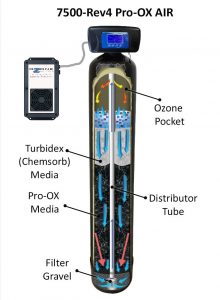
Water may be clear when first drawn from a hose bib or faucet, but then turn rusty later. This is iron that is dissolved in the water but later will turn to rust once it is exposed to air.
Exposure to air can happen anywhere or anytime, such as in the toilet, washing machine, or bath. To determine the type of iron, fill a clean white 5-gallon bucket with water. If the water is clear without a tint or color, you have primarily ferrous iron.
The solution to Clear Water Iron
Use an oxidizing ceramic disc iron filter such as Pro-OX or other manganese dioxide iron filters to turn the dissolved iron to rust form, where it is then filtered out by the iron filter. This type of air injection iron filter is very effective at removing both ferric iron and ferrous iron.
An automatic backwash keeps the Pro-OX filter media clean and the optional ozone generator prevents iron bacteria from fouling the filter media. Often these iron filters use built-in air or ozone injection to enhance the oxidizing ability of the filter media.
Red Water Iron (Rust)
Also known as ferric iron (rust) this is iron that has already been exposed to some oxidation and is no longer dissolved in the water. Rarely does water contain only ferric (rust) iron.
Often part or some of the water is oxidized and the rest of the water has clear water iron. Many iron filters such as the Pro-OX Air system filters out both rust and dissolved iron.
The Solution to Red Rusty Water
As above, also use an oxidizing iron filter which removes both clear water iron and red water iron. For some water with very high levels of iron in rust form a backwashing sediment filter in series with a Pro-OX or similar iron filter is recommended.
The Pro-OX air injection iron filters will remove both rust and dissolved iron.
Organic Iron
Some waters contain high levels of tannins which can enter the well water from the surface. Materials such as organic leaves, grasses, and other plant materials cause Tannins. These organic compounds can bind with iron.
Solutions to Treat Organic Iron
Use chlorine bleach, hydrogen peroxide, or ozone gas to feed ahead of the iron filter with sufficient contact time by using a retention tank. After filtering with a manganese dioxide iron filter, follow with an activated carbon filter.
The chlorine (or peroxide) will break down the organic bonds.
In some cases, if the iron is colloidal (microscopic particles that cannot be easily settled out or filtered) then we feed in alum or polymer coagulant to clump the particles into larger particles that can be filtered.
Iron Bacteria
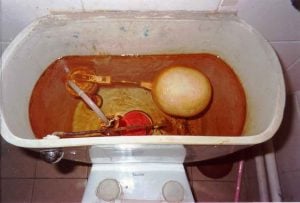
Iron bacteria (as well as iron and sulfur bacteria) is a general term used to describe various species of bacteria that use iron to live and grow. Iron becomes part of their cell walls and the end result is a slimy stringy growth that can be seen in toilet flush tanks.
The iron bacteria creates a biofilm in pipes and water heaters where it lives and grows, producing various sulfur and pond odors.
The stringy growths can also line pipes and build up in water tanks, fixtures, and appliances.
Solutions to Treat Iron Bacteria
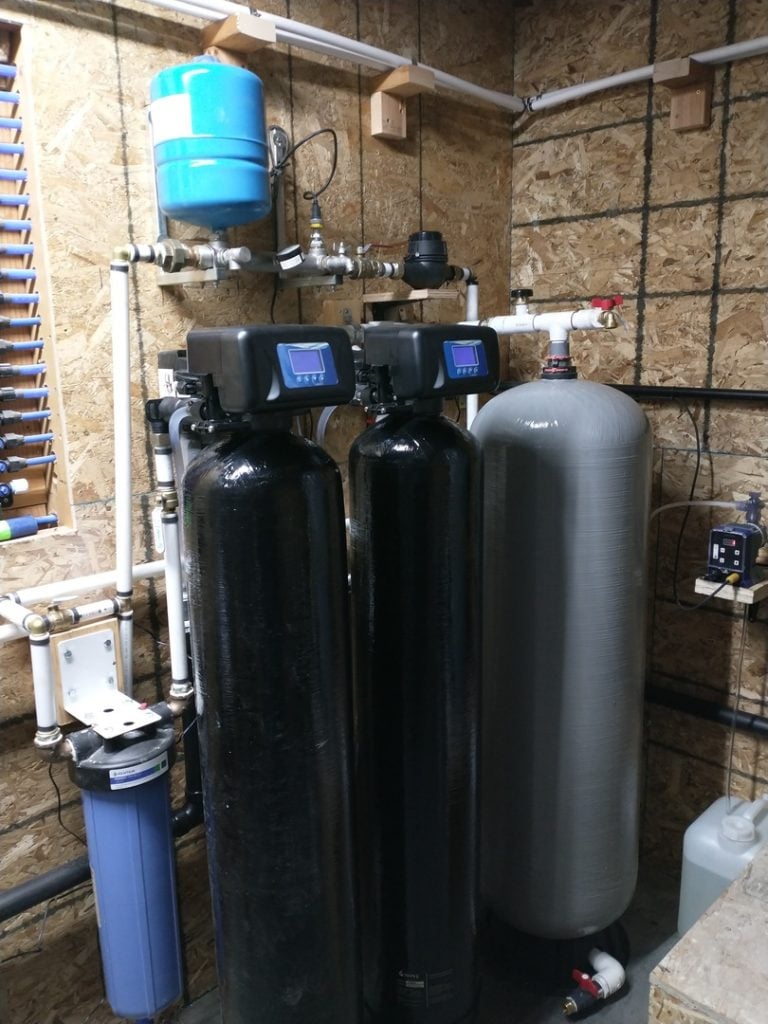
Iron and sulfur bacteria live and grow in biofilms coating pipes and well lining. Clean up the well and pipes at least annually to reduce biofilm buildup with a simple chlorine shock of the well and pipes. Shock treat your household piping once a year with bleach to clear out biofilm in the pipes.
For treatment and filtration, we recommend a chlorine injection system to disinfect the water and kill the iron bacteria, followed by a Pro-OX iron filter. A carbon backwash filter can be used after the iron filter to remove any residual chlorine and provide a secondary barrier.
Chlorine bleach is much more effective at eliminating iron bacteria than hydrogen peroxide however, ozone is another option that is effective as well.
Chlorine actually kills the bacteria and disinfects the water, whereas peroxide injection won't kill the bacteria, but it does introduce oxygen into the water which makes it more difficult for these bacteria to live, which thrive in oxygen-starved waters.
Don't want to use a continuous chlorine feed?
Use a Pro-OX Iron Filter with Ozone and then periodically shock treat your well and pipes with chlorine bleach to reduce bio-films.
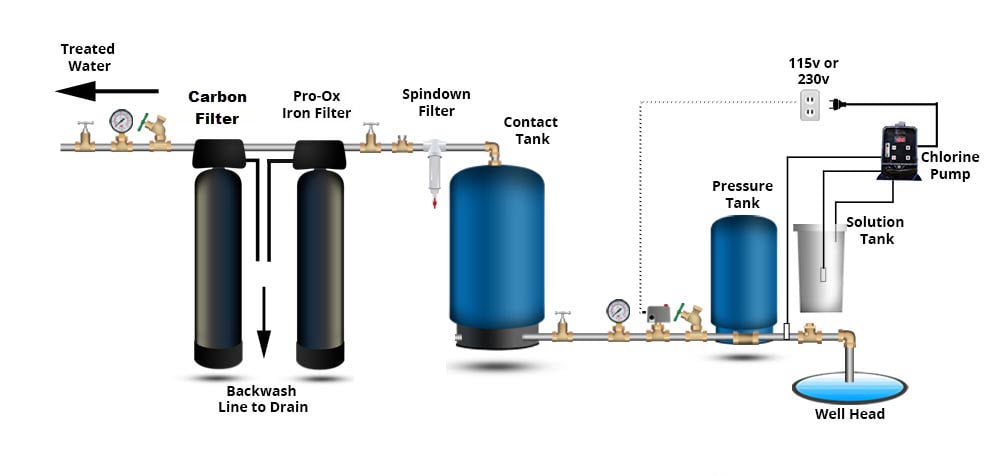
Use Home Tests to Find Out What's In Your Water

A water test is important to know which type of iron filter to use and if your water is acidic or not.
A water test will tell you how much iron you have. This knowledge helps you to choose the type of approach or system you should use to treat it.
Tests should include alkalinity, hardness, hydrogen sulfide, iron, manganese, pH, and total dissolved solids. If the water has a tea color to it or has a yellowish-clear color to it, then a tannin test is recommended as well.
You should always include a pH test, which indicates if the water is acidic or alkaline. The ideal pH for iron filters to work properly is between 7.0 and 8.0, which is considered neutral and not acidic.
For health-related concerns include a test for total coliform, e-coli (fecal coliform), lead, and nitrate. Complete mineral, metals, and bacteriological tests from a State certified laboratory are recommended; especially if infants and children will be drinking the water.
When the source of your water is a public water system and you experience iron-related problems, it is important to contact your water company to determine whether the red water is from the public system or from the home’s plumbing or piping.
Check For Odors in Well Water & Water Heater

If you smell a “rotten egg” odor, this is hydrogen sulfide gas. If the water smells like oil or asphalt this can be from manganese. If the water smells like cucumber or sewage this is usually a result of iron and/or sulfur bacteria.
Run the water hot water from each tap and notice if there is an odor in the
hot water, that is not in the cold water. This indicates a problem with the water heater. Iron and sulfur bacteria can interact with the anode rod in water heaters, resulting in hydrogen sulfide gas only in hot water.
Perform a “Toilet Tank Inspection”
Unless your toilet tank is new or has recently been cleaned your toilet flush tank can be a wealth of useful water quality information! Simply lift the cover and look in. If you see slimy rusty deposits on the sides of the tank and frothy bubbles in the tank water, this is a good indication of iron bacteria.
Oxidizing Iron Filters
Iron filters oxidize the dissolved ferrous iron in water to an insoluble particle. Then the filter traps the iron (rust) in the iron filter media. A periodic backwash cleans out the rust & flushes the filter media clean. Various types of iron filter media are available including Birm, including Greensand, Pro-OX, Filox™, & Pyrolox™.
Oxidizing iron filters use either air, potassium permanganate, chlorine or ozone to aid the filter media in oxidizing the iron. Some brands are Filox™, Pro-OX™, and Pyrolox™. They are all solid manganese dioxide media not coated.
Most iron filter media uses a thin coating of manganese dioxide over some other type of filter media. Solid manganese dioxide media are the gold standard for iron filtration media. The media lasts for many years, often 15 to 20 years and these systems can filter the water at a faster rate.
The solid manganese dioxide types of filter media are the gold standard for iron filtration media. The media lasts for many years, often 15 to 20 years. These systems can filter the water at a faster rate of flow than the coated types of media.
The type we use is called Pro-OX and is a little higher in purity than other manganese ore media. It is NSF certified for drinking water and is naturally processed and cleaned and graded. It is also highly porous and works well at manganese removal as well as iron removal from well water.
Which Type Of Iron Filter is Best?
For best results, lowest maintenance, and longer life we recommend a high purity manganese dioxide filter media such as Pro-OX Iron Filters.
If you have hard water, use a good quality water softener after the iron filter to get super clean, soft, clear, water in the house.
Our company has customers with iron filters that have the same manganese dioxide media filters installed over 15 years ago. The filter media lasts many years longer than greensand, or other manufactured coated filter media.
If sulfur odors or manganese are present, we recommend that you use a chlorinator injection system in front of the iron filter, or select the air or ozone option. The Pro-OX with Ozone option system works best if you have a sulfur odor, manganese, or iron bacteria.
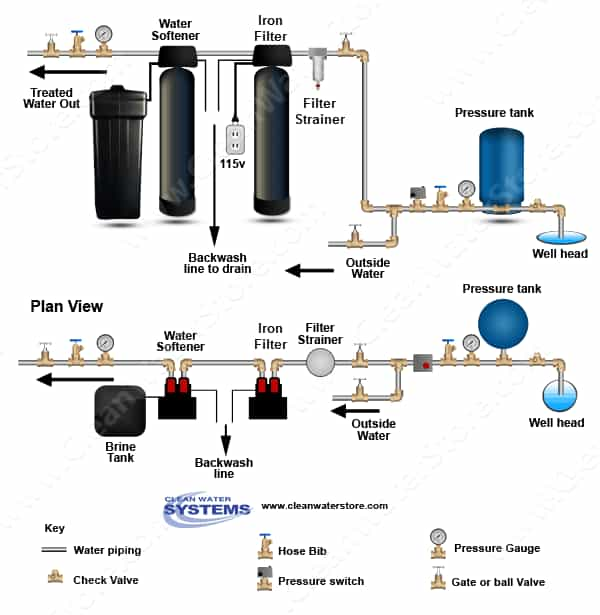
Air Charging Iron Filters Remove Iron, Manganese and Sulfur Odor

When used with a solid manganese dioxide filter media such as Pro-OX, it can last for many years with little or no maintenance. No chemicals are required.
This type of iron filter maintains an “air pocket” at the top of the tank while the system is in service. As the water passes thru the air pocket, iron and sulfur are oxidized. Additionally, dissolved oxygen is added to the water. The iron filter media bed then removes the iron and sulfur from the water.
When used with the Ozone Option, these iron filters can generally remove up to 8 ppm hydrogen sulfide and up to 8 to 10 ppm Iron. The backwash removes accumulated iron and replenishes the filter media bed and adds a fresh air pocket to the system.
This type of iron filter is one we recommend most often as it works best for most of our customers and is the easiest to maintain.
Check for Pipe Corrosion & Scale Build-up
Sulfur odors can cause sulfuric acid to build up in water and corrode piping and fixtures. Unless your home is new, it is important to check for pipe corrosion scale build-up in the piping. Fortunately, this is not difficult to do by using one of the following methods:
Check for signs of blue stains in fixtures, blue stains in toilet tanks, which can indicate copper corrosion, and/or test water for copper.
If you have galvanized iron pipe, look for signs of rust and rust-colored scale in the toilet flush tank.
If possible, inspect the exterior of pipes and valves, to see if you see any signs of pinhole leaks or corrosion by-products which can be crusty, bluish, white or salty looking or rusty.
If you are having any plumbing work done on your house, inspect any sections of the pipes that have been cut to see if there is any scale build-up or signs of corrosion.
Identify Pipe Sizes
It is useful to know the size of your incoming pipes. For instance, say you decide you want to install an iron filter system for your house. They come in different pipe sizes, such as ¾” pipe, 1″ pipe, etc. Generally, you want to make certain you get a system that will not restrict the water flow or pressure, so if you have a 1″ pipe, you would want an iron filter that has 1″ pipe connectors. Knowing what size piping you have solves this problem.
It is easy to check the size of your pipes. First, check on the pipe itself, often it will be labeled or written on the side. If not, the string method which measures the circumference is probably the best way to determine your pipe size. The circumference is the distance it takes to go around the pipe once.
Using a piece of string about 6″ long (or a cloth tape measure) wrap the string around the pipe once and measure to the nearest 1/8 of an inch. Once you have found the circumference, use the chart below to find your pipe or tube size.
1. What are the common effects of iron and manganese in well water?
Iron and manganese in well water can cause stains and a metallic taste. Iron can cause red, brown, or yellow stains, while manganese can cause brown or tea-colored stains.
2. What questions should I ask when choosing an iron filter for my well water?
You should ask about the type of iron in your water system, the chemistry of your well water, the source of the iron and/or odor, and the flow rate available from your well pump or booster pump.
3. What are the different types of iron found in well water?
There are four main types of iron found in well water: Soluble “Clear Water” Iron, Insoluble Oxidized “Red Water” Iron, Organic Iron, and Iron Bacteria.
4. How can I treat Clear Water Iron in my well water?
Clear Water Iron can be treated using an oxidizing iron filter such as Pro-OX or other manganese dioxide iron filters.
5. What is the recommended treatment for Iron Bacteria in well water?
For Iron Bacteria, it's recommended to use a chlorine bleach feed to disinfect the water and kill the iron bacteria, followed by a Pro-OX iron filter. In place of chlorine use the optional ozone generator with the Pro-OX iron filter.
6. Why is it important to conduct a water test before choosing an iron filter?
Conducting a water test is important to determine the type of iron and the pH of the water. This information is crucial for the iron filter to work properly.
7. What is the ideal pH for iron filters to work properly in well water?
The ideal pH for iron filters to work properly is between 7.0 and 8.0, which is considered neutral and not acidic.
8. What are the differences between oxidizing iron filters and air charging iron filters?
Oxidizing iron filters use either air, potassium permanganate, chlorine or ozone to aid the filter media in oxidizing the iron. Air charging iron filters maintain an “air pocket” at the top of the tank while the system is in service, which helps oxidize the iron and sulfur and use no potassium permanganate.
9. Why is a high-purity manganese dioxide filter media such as Pro-OX recommended?
The author recommends a high-purity manganese dioxide filter media best results, the lowest maintenance, and longer life. Coated media such as greensand or other manufactured coated media can wear off and be damaged by low pH and other factors.
10. What should I do if sulfur odors or manganese are present in my well water?
If sulfur odors or manganese are present, it's recommended to use a chlorinator injection system in front of the iron filter or select the air or ozone option.
Additional Resources:
U.S. Environmental Protection Agency (EPA) – Drinking Water The EPA's page on drinking water provides a wealth of information on water quality, safety, regulations, and more.

